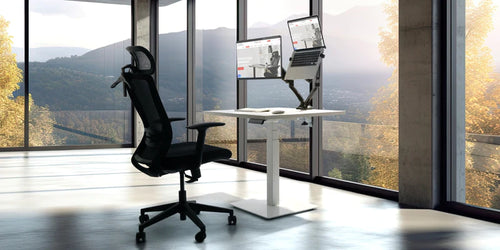In today’s work culture, many of us spend many hours at our desks, making the dynamics of our office environments increasingly important, even for the home office. The choice between standing and sitting desks has become a discussed topic, centering on the impacts on health and efficiency.
The market now offers a wide array of high-quality smart work furniture, so you can choose your perfect economy standing desk and ergonomic chair, catering to the comfort and well-being of users, whether they stand, sit, or switch between the two during their day. Let’s learn more about the nuances that distinguish standing desks from sitting desks, examining their effects on health, productivity, ergonomic benefits, cost-effectiveness, and flexibility.
Discover Health Impacts with Both Standing and Sitting Desks
Standing Desks
Standing desks offer a dynamic solution to the sedentary lifestyle that comes with traditional sitting arrangements, promoting physical activity in the workplace. These desks encourage a shift from constant sitting to standing, which has been associated with lower incidences of obesity, cardiovascular diseases, and type 2 diabetes, playing a vital role in preventive health measures.
Standing rather than sitting enhances blood flow, crucial for sustaining energy and avoiding the discomfort and rigidity associated with remaining seated for extended periods. Standing desks support a more active stance, which not only helps in maintaining good posture but also in alleviating back pain. This benefit stems from the engagement of various muscle groups in a balanced manner, preventing the overloading of any single muscle group throughout the day.
Sitting Desks
Extended periods of sitting are linked with an increased likelihood of obesity, cardiovascular diseases, diabetes, and a downturn in metabolic health. Long sitting spells can also cause poor posture and intensify back problems, as the human body isn’t designed for prolonged inactivity. Such stationary postures can put undue pressure on the neck, shoulders, and back, causing discomfort and potential long-term health issues. Recognizing these risks underscores the importance of workplace strategies that promote regular movement and changes in posture.
Employing ergonomic solutions like adjustable chairs and desks, combined with frequent breaks for physical activity, can alleviate some negative impacts of extended sitting, fostering a healthier, more active work environment.
Getting Work Done and Your Way to Productivity
Standing Desks
Studies show that standing desks can boost work output because they make people more alert and energetic. The act of standing increases blood flow and oxygen to the brain, which helps keep you sharp and focused.
The ability of standing desks to switch between sitting and standing easily is key in reducing tiredness. This means people can change their stance during the day as needed, helping avoid the drop in focus that often comes with long periods of sitting. Moving between sitting and standing can also help spark new ideas and keep the brain engaged.
Sitting Desks
Traditional sitting desks are often chosen for comfort, which can help with concentrating on long stretches. But, they can lead to a lifestyle with little movement, which has its downsides. While sitting can make it easier to focus on tasks that need a lot of attention, staying seated for too long can sap energy over time.
Making Work Comfortable
Standing Desks
Standing desks encourage an active way of working by letting you change your posture, which can be better for your health and comfort. These desks can be adjusted to fit each person, making sure everything from your screen to your keyboard is set up right. This helps prevent problems like neck or back pain and shoulder tension that can come from sitting still too long.
Being able to change the height of the desk means different body shapes can be accommodated, and you can move around more, using different muscles and avoiding stiffness or muscle weariness. These changes can also help blood circulation and keep you physically involved in your work.
Sitting Desks
Ergonomic sitting desks and chairs aim to cut down on health issues from sitting a lot by supporting the right posture and reducing strain. These pieces of furniture are made to fit the body’s natural position, supporting different body areas to prevent injuries or body pain.
The support they offer helps lessen pressure on parts of the body that often suffer from bad sitting habits, like the lower back and shoulders. This can make sitting more bearable and sustainable. But to benefit from these desks, it’s important to stand up and move around regularly. Even with ergonomic design, sitting too much can still lead to health problems if not mixed with some standing and walking around.
Price
Standing Desks
Standing desks, with their advanced features, often come with a higher price tag compared to regular sitting desks. They offer the flexibility to switch between sitting and standing, which can improve health and productivity. The higher cost reflects the sophisticated engineering and design that go into making these desks robust, adaptable, and easy to use.
Sitting Desks
Traditional sitting desks are known for being more budget-friendly, with a wide variety of styles and materials to choose from. This makes them a practical choice for many people and businesses. They offer flexibility in office design, allowing for customization to suit different tastes and financial limits. The lower price of sitting desks makes them attractive for setting up office spaces or home studies, particularly when buying many at once or working within a strict budget.
Finally, deciding between a standing desk and a sitting desk hinges on your own goals. A key advantage of standing desks is their versatility, allowing users to switch between sitting and standing, thereby combining the benefits of a conventional sitting desk.
















